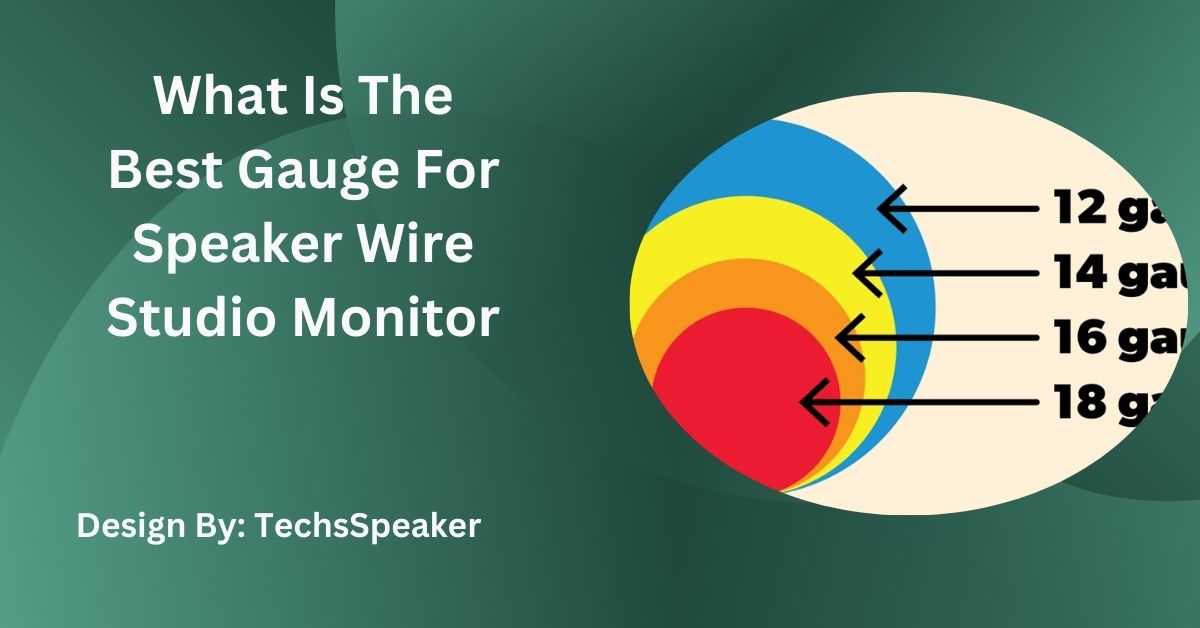For studio monitors, use 12 AWG wire for runs up to 50 feet and high power. For shorter runs up to 20 feet, 14 AWG is ideal. 16 AWG works for small setups.
For most studio monitor setups, 16-gauge speaker wire is a great choice. It offers a good balance of affordability and performance. However, for longer cable runs or higher-powered setups, 14-gauge wire might be more suitable.
When setting up your studio monitors, the quality of your speaker wire can make a significant difference in audio performance. While many elements contribute to a well-functioning sound system, selecting the right gauge of speaker wire is crucial for optimal audio quality and system safety.
This guide will walk you through the nuances of speaker wire gauges, helping you make an informed decision for your studio setup.
The gauge of a speaker wire refers to its thickness. Measured in American Wire Gauge (AWG), a lower number indicates thicker wire, which can carry more current over longer distances. Choosing the correct wire gauge ensures that your speakers receive adequate power without resistance losses, which can degrade sound quality and potentially damage your equipment.
- Audio Quality: Thicker wires reduce resistance, enabling more of the amp’s power to reach the speakers. This improves sound clarity and reduces distortion.
- System Safety: Using a wire that’s too thin for your setup can cause overheating and potentially damage both the wire and connected devices.

Here’s a breakdown of the most common wire gauges and their typical use cases:
- Use Case: Best for long runs exceeding 50 feet and high-power setups.
- Benefits: Handles more power with minimal resistance, ensuring high-quality sound transmission over long distances.
- Use Case: Suitable for runs between 20-50 feet and moderate to high-power systems.
- Benefits: Combines good power handling with flexibility, making it a popular choice for many studios.
- Use Case: Ideal for shorter runs up to 20 feet and moderate power systems.
- Benefits: Offers a balance between cost-effectiveness and performance.
- Use Case: Good for small home studios and short runs up to 10 feet.
- Benefits: Affordable and sufficient for low to moderate power needs.
- Use Case: Suitable for low-power applications and very short distances.
- Benefits: Cost-effective for budget setups but not recommended for professional use.
Consider the following when determining the appropriate gauge for your studio monitors:
- Distance: Longer wire runs require thicker wire to minimize resistance and maintain audio quality.
- Power Requirements: Higher power speakers need thicker wire to handle the current without overheating.
- Impedance: Lower impedance speakers (4 ohms) require thicker wire compared to higher impedance ones (8 ohms).
- Measure the Distance from your amplifier to the farthest speaker.
- Check the Power Rating of your speakers in watts.
- Determine the Impedance (ohms) of your speakers.
Use a wire gauge chart or online calculator to find the right gauge based on these parameters.
- Setup: Small home studio with 8-ohm, 50-watt speakers located 10 feet from the amp.
- Wire Choice: 16 AWG
- Reason: Short distance and moderate power requirements make 16 AWG sufficient.
- Setup: Professional studio with 4-ohm, 150-watt speakers 30 feet from the amp.
- Wire Choice: 12 AWG
- Reason: Higher power and longer distance necessitate a thicker wire to ensure audio quality and safety.
Also Read: What Is The Best Gauge For Speaker Wire Studio Model – Complete Guide!
- Thicker is Always Better: While thicker wires reduce resistance, they are not always necessary. Over-specifying can lead to unnecessary costs.
- All Wires are the Same: Quality varies. Look for wires with high strand counts and oxygen-free copper for better performance.
- Gauge Doesn’t Affect Sound: Incorrect. The wrong gauge can result in signal loss and reduced audio fidelity.
- Monoprice Access Series: Offers oxygen-free copper and various gauge options.
- Amazon Basics: Provides affordable and reliable speaker wire for budget-conscious users.
- Mediabridge Ultra Series: Known for durability and excellent conductivity.

To achieve the best possible audio performance, consider advanced wiring techniques such as bi-wiring and bi-amping. Bi-wiring involves using separate wires for the high and low frequencies, which can reduce interference and improve sound clarity.
Bi-amping, on the other hand, dedicates separate amplifiers to power different speaker drivers, further enhancing sound precision and system control. These methods may require additional equipment and knowledge but can significantly elevate your studio’s audio experience.
Proper installation and maintenance of your speaker wires are essential for ensuring long-lasting, high-quality audio performance. When installing wires, ensure they are securely connected and routed away from sources of interference, such as power cables.
Regularly inspect your wires for wear and tear, and clean any connectors to prevent signal degradation. Keeping your cables well-organized and labeled can make troubleshooting and future upgrades more manageable.
The right gauge ensures optimal audio performance and system safety by minimizing resistance, reducing distortion, and preventing overheating in your studio setup.
For a small home studio with short runs up to 10 feet, 16 AWG wire is typically sufficient, providing a balance of performance and cost.
For long distances over 50 feet in a professional studio, 10 AWG wire is ideal due to its ability to handle high power with minimal resistance.
Thicker wires reduce resistance, allowing more power to reach the speakers, which improves sound clarity and reduces distortion.
A common misconception is that thicker wires are always better; however, over-specifying can lead to unnecessary costs. Quality and correct gauge selection are more important.
Choosing the right speaker wire gauge is crucial for achieving the best audio performance in your studio. Understanding the importance of wire thickness, calculating based on distance and power needs, and considering speaker impedance ensures minimal resistance and optimal sound quality. By selecting the appropriate gauge and maintaining your wires properly, you can enhance your studio setup, avoid signal loss, and protect your equipment from potential damage, leading to a superior audio experience.
